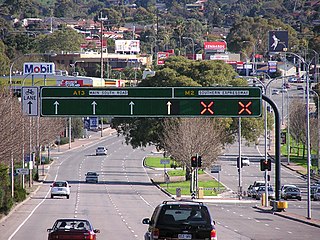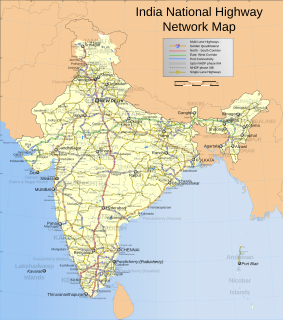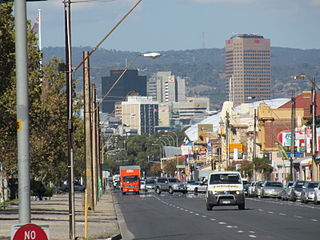
Adelaide Metro is the public transport system of Adelaide, the capital city of South Australia. It is an intermodal system offering an integrated network of bus, tram, and train service throughout the metropolitan area to 63 million riders annually, with an average daily ridership of 173,000 people. The system has evolved heavily over the past fifteen years, and patronage increased dramatically during the 2014–15 period, a 5.5 percent increase on the 2013 figures due to electrification of frequented lines.

The O-Bahn Busway is a guided busway that is part of the bus rapid transit system servicing the northeastern suburbs of Adelaide, South Australia. The O-Bahn system was conceived by Daimler-Benz to enable buses to avoid traffic congestion by sharing tram tunnels in the German city of Essen.

The Southern Expressway is an 18.5 km (11.5 mi) freeway in the southern suburbs of Adelaide, South Australia, between Bedford Park and Old Noarlunga.

A controlled-access highway is a type of highway which has been designed for high-speed vehicular traffic, with all traffic flow ingress- and egress-regulated. Common English terms are freeway, motorway and expressway. Other similar terms include Interstate and parkway. Some of these may be limited-access highways, although this term can also refer to a class of highway with somewhat less isolation from other traffic.

South Road, also known as Main South Road, is a major north–south conduit in Adelaide and Fleurieu Peninsula in South Australia. It is one of Adelaide's most important arterial and bypass roads.

The metropolitan area of Adelaide, South Australia is served by a wide variety of transport. Being centrally located on the Australian mainland, it forms a hub for east-west and north-south routes. The road network includes major expressways such as the Southern Expressway, the South Eastern Freeway, the Port River Expressway, the Northern Expressway and the South Road Superway. The city also has a public transport system managed by Adelaide Metro, consisting of a contracted bus system including the O-Bahn Busway, six metropolitan railway lines, and the Glenelg-Adelaide-Hindmarsh Tram. According to a study conducted by the Australian Bureau of Statistics, Adelaide has the highest passenger vehicle travel to work (84%) and the second lowest proportion of people walking to work (2.9%)–something that is being combated by the South Australian government in an effort to increase citizen ridership and use of public transport.

The Metropolitan Adelaide Transport Study, or "MATS Plan" as it became known, was a comprehensive transport plan released in 1968 proposing a number of road and rail transport projects for the metropolitan area of Adelaide, South Australia.

The National Highways Development Project (NHDP) is a project to upgrade, rehabilitate and widen major highways in India to a higher standard. The project was started in 1998 under the leadership of then Prime Minister, Atal Bihari Vajpayee. National Highways account for only about 2% of the total length of roads, but carry about 40% of the total traffic across the length and breadth of the country. This project is managed by the National Highways Authority of India (NHAI) under the Ministry of Road, Transport and Highways. The NHDP represents 49,260 km of roads and highways work and construction in order to boost economic development of the country. The government has planned to end the NHDP program in early 2018 and consume the ongoing projects under a larger Bharatmala project.
The Port River Expressway is a 5.5-kilometre (3.4 mi) freeway-grade road. The expressway links Port Adelaide and the LeFevre Peninsula to the northern suburbs of Adelaide and major interstate routes via Salisbury Highway (A13) to Port Wakefield Road (A1) and the Max Fatchen Expressway (M20) to Perth, Darwin and Sydney.

The M4 Western Motorway is a 46-kilometre-long (29 mi) dual carriageway motorway in western Sydney, New South Wales, Australia. The partially-tolled motorway stretches from North Strathfield in the east, where it connects with the Great Western Highway/Parramatta Road as the A4 to Glenbrook in west, where it continues as the Great Western Highway as the A32.

Port Road is a major road in Adelaide, South Australia connecting the Adelaide city centre with Port Adelaide. It is 12 km (7.5 mi) long, and has a very wide median strip, giving a total width of approximately 70 m.

The Hunter Expressway is a 39.5-kilometre (24.5 mi) long dual carriageway freeway in New South Wales, Australia. It was previously known as the F3 to Branxton link or Kurri Kurri Corridor during the planning stage. It has two lanes in each direction, running generally north west from the Pacific Motorway at the Newcastle Link Road interchange to the eastern end of the Belford Bends Deviation on the New England Highway north of Branxton. The road allows traffic to bypass the Maitland area, Lochinvar, Greta and Branxton. The expressway opened on 22 March 2014.
This is a list of freeways in Australia, sorted by states and territories and their corresponding routes. This list includes tollways / toll roads such as the CityLink freeway system in Melbourne. This list has over 70 entries. The only jurisdiction in Australia without freeways is the Northern Territory. Victoria has the largest and densest freeway network in Australia.
The Northern Connector is a 15 kilometre long expressway under construction in Adelaide, South Australia. It will connect the North-South Motorway at Wingfield to the Northern Expressway (M2) as part of an ongoing plan to develop a continuous freeway grade road between Old Noarlunga and Nuriootpa known as the North–South Corridor. The road will be built with three lanes in each direction and provide a faster, safer and less congested route over the section of the North-South Corridor between South Road and the Northern Expressway. Construction began in January 2016 with completion in December 2019.

The Hobart Area Transportation Study was a comprehensive transport plan released in 1965 for the purpose of examining the transport needs of the Australian Hobart metropolitan area over the proceeding 20 years. The study predicted the majority of the proposed traffic corridors would need to be operational by the 1985 target year.
NorthConnex is a 9-kilometre (5.6 mi) motorway tunnel under construction in northern Sydney, New South Wales, Australia. When completed in 2020, it will connect the M1 Pacific Motorway to the M2 Hills Motorway. It was previously known as the F3 to M2 link, then the M1 to M2 link after alpha numeric route numbers began to be used in New South Wales. The road has also colloquially been referred to as the "missing link", because its construction will complete the combination of the Sydney Orbital Network and its north-south motorway links to the National Highway.
York Civil was a South Australian construction and civil engineering company based in Adelaide, South Australia. It was founded in 1990 by Ian Tarbotton, who remains an owner and director along with Dominic Vieceli. It began with only 10 employees, but said it had over 400 by 2017 with offices in four states and 190 when it was wound up in August 2018.

























